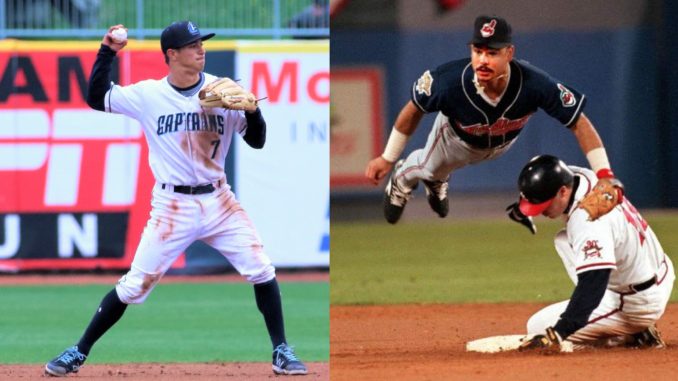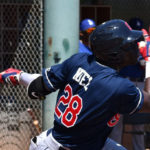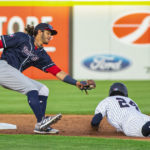
2020 marks the 25th anniversary of one of the greatest Cleveland Indians seasons of all time. The team hadn’t had a winning season since 1986, and it hadn’t appeared in the playoffs since 1959. After a strong showing in the strike-shortened 1994 season, the Indians were primed for success in 1995. They didn’t disappoint.
The Indians dominated the AL Central, finishing 30 games ahead of the second place Royals and compiling a 100-44 record. Cleveland’s success continued in the ALDS, where the team swept the Boston Red Sox in four games. The road got tougher in Seattle. The Indians had to overcome a Mariners roster led by Randy Johnson and Ken Griffey Jr., but they triumphed in six games in one of the most exciting League Championship Series in recent memory.
Then came the World Series. The Indians’ high-powered offense was up against future Hall of Famers Greg Maddux and Tom Glavine. While the Tribe ultimately fell in six games, all but one game was decided by one run. The disappointment stung, but it set the team up for a run of success Cleveland has rarely seen from its sports teams.
Which brings us to today. As I’ve preached to anyone who will listen, the Indians have one of the best farm systems in the game. While the system may be light on Top 100 prospects, the overall depth of the system has the team set for another run of success in the middle of the decade.
Talented young players were one of the keys to the 1995 Indians’ success. Between strong development and a few savvy trades to bolster the farm system, the Tribe found the road to success. Current president Chris Antonetti and today’s Indians’ front office have taken this approach over the last several years to create an environment very similar to the early 90s. So let’s take a look at the 1995 World Series roster and compare to today’s prospects!
For this list, I’ll compare every player who appeared in the 1995 World Series for the Indians to a player in today’s system who best emulates that player’s skill set. Some names will be familiar from the Indians’ Top 50 list, and some will be lesser-known players. All players on this list have not appeared in a Major League game.
Then: Albert Belle, LF – Belle had one of the all-time great offensive seasons in 1995, slugging 50 home runs and 52 doubles. To this day, he remains the only member of the 50/50 club. In addition, Belle paced the league in runs scored and slugging percentage, and he tied Boston’s Mo Vaughn with 126 RBI. He put up a .317 average and 1.091 OPS to drive the Indians’ offense from the clean-up spot.
Now: Will Benson, OF – With apologies to Bobby Bradley, Benson has the best raw power in the Indians’ farm system. Out of every player in the organization, Benson is the easiest to envision matching Belle’s 50/50 season. In addition, Benson can steal a bag or two – Belle swiped 23 bases in 1993. While Benson still has work to do to in the BA and OBP departments, his all-around talent looks a lot like Belle’s.
OTD: 1️⃣ year ago, Will Benson (@_thekidbilly_) was a human launching pad! 🚀 pic.twitter.com/03uCt7FFqf
— Lake County Captains (@LCCaptains) April 18, 2020
Then: Kenny Lofton, CF – For five years, Kenny Lofton was the fastest man in the American League. In 1995, he stole 54 bases. He did this with a .310 batting average and a respectable .453 slugging percentage. Lofton sparked the offense from the lead-off spot. His heroics in Game 6 of the ALCS gave the Indians the momentum to seal the victory and advance to the World Series.
Now: Quentin Holmes, CF – Holmes still has a lot of work to do at the plate to be compared to Lofton. But despite putting up an OBP of .247 in 2019, he successfully stole 23 of 32 bases. Holmes is a solid-fielding, lightning-fast center fielder. Because of his speed, he’s the first and last outfielder in the conversation when it comes to drawing a Kenny Lofton comparison.
Then: Manny Ramirez, RF – Ramirez played his first full season in right field in 1995, and he proved he should have triumphed over the Royals’ Bob Hamelin in the 1994 Rookie of the Year voting. Ramirez hit out of the seven-hole in 1995, but his .960 OPS would have played anywhere in the Tribe’s lineup.
Now: George Valera, RF – Valera, like Holmes, could be a spitting image of his 1995 counterpart. Valera has the smooth swing to hit for average and the raw power to slug near .600. The good news for Tribe fans is that Valera profiles as a much better defender than Ramirez. Whereas Manny made some…questionable…decisions in the outfield, Valera’s baseball IQ points to him being an all-around above average if not great player at the major league level.
Then: Eddie Murray, 1B – Murray is one of the greatest hitters to ever play the game. While he only spent two plus years late in his career in Cleveland, he was the high-contact, impact bat the Indians needed behind Albert Belle. Pitchers couldn’t pitch around Belle, because they still to contend with Murray and his .323/.375/.516 line.
Now: Bryan Lavastida, C – The first position change on this list, Lavastida has both the hitting talent and athleticism to be the average and power threat any good team needs out of a fifth batter. Lavastida came up as an infielder, and he’s succeeded as a professional catcher. While he’ll likely remain behind the plate, he has the ability to be the protector in the five spot from any position on the field.
Then: Carlos Baerga, 2B – Baerga was the player that did everything good, but nothing great. He wasn’t a pure all-around hitter like Murray, nor would he hit tape measure homers like Belle and Thome, but Baerga’s .314/.355/.452 line was exactly what the Indians needed from their third batter.
Now: Tyler Freeman, IF – Freeman and Baerga are another pair whose stats could be mistaken for each other’s. Freeman put up a .306/.368/.410 line in 2019, and he’ll likely find a home at second base. With the evolution of today’s game versus 1995, Freeman will probably find himself batting second against Baerga’s third, but he profiles as a very similar player.
Then: Omar Vizquel, SS – The discussion of Omar Vizquel starts with his glove. He’s one of the best-fielding shortstops the game ever has and ever will see. But Vizquel was also solid at the plate. While he was never a power hitter (he only hit more than 10 HR in a season once in his career), Vizquel put up a .333 OBP and stole 29 bases in 1995. Whether hitting behind Kenny Lofton in the two spot or ahead of Lofton from the nine hole, the duo ran wild on opposing teams.
Now: Jose Fermin, SS – “But what about Brayan Rocchio?!” I expect Rocchio to develop into a Francisco Lindor type, slugging 20+ HRs a year. Fermin is more of a contact hitter and slick-fielding short stop, a la Vizquel. Fermin profiles well as a high-average, base-stealing shortstop with a strong glove who will thrive well batting second or ninth. He also stole 28 bases last year, one shy of Vizquel’s 29 in 1995. He’s the closest to Vizquel the Indians have in the system.
#Indians 19yr old (SS) prospect Jose Fermin with an unassisted double play tonight to end the game against the Angel’s. #Future pic.twitter.com/IoyV75CXtD
— Indians Prospective (@indiansPro) March 21, 2019
Then: Jim Thome, 3B – While he spent most of the 1994 season in Cleveland, third base officially became Thome’s home in 1995. He was the left-handed power bat hitting out of the six hole the Indians needed. We know about his home run prowess, but Thome was also incredibly patient at the plate, drawing 97 walks and putting up a .438 OBP. He could drive in runs and set up the bottom third of the order from his spot in the lineup.
Now: Nolan Jones, 3B – This is probably the easiest comparison to draw. Like Thome, Jones is a 30+ HR prospect who strikes out but also draws a lot of walks. Also like Thome, I expect Jones to eventually transition to first base. The profiles between the two players are uncanny – Both are even left-handed hitting, right-handed fielding players. Don’t be surprised if Jones’ career follows the same trajectory as Thome’s.
Then: Sandy Alomar Jr., C – Alomar was the starting catcher the Indians needed behind the plate in 1995. Another solid hitter in a roster of many, Alomar put up a .300/.322/.478 line to set the table for the top of the order. Alomar’s .995 fielding percentage only increased his value to the team.
Now: Bo Naylor, C – Another easy comparison, Naylor looks to be this generation’s version of Sandy Alomar Jr. Naylor was drafted for his bat, and he’s developing into a hitter in the mold of Alomar. Naylor’s defense has also continued to improve as he’s worked through the Indians’ system, and a Gold Glove isn’t out of the question.
Then: Paul Sorrento, 1B/DH – Sorrento’s bat played well as a platoon 1B/DH for the Indians in 1995. While his .235 batting average may not be Silver Slugger-worthy, his .511 slugging percentage provided an extra jolt of power late in the batting order. Sorrento drove in 79 runs in 104 games to form one half of an effective platoon.
Now: Michael Cooper, 1B – An unlikely candidate for this list, the 2017 33rd round pick has the chance to develop into a Paul Sorrento type. Cooper spent 2019 in Low-A Mahoning Valley, and had a pedestrian season with a .238/.295/.336 line. He’s a big right-handed hitter who may never hit much for average, but he has the size to consistently put the ball over the fence. If he continues to develop as a hitter and make solid contact at a higher rate, he could be a strong platoon candidate in the future.
Mahoning Valley Scrappers 19yr old 1B Michael Cooper with his 1st HR of the year a 2 run shot in the 3rd inning tonight vs West Virginia. @BigCoop2899 #Indians pic.twitter.com/j0k1HH8uey
— Indians Prospective (@indiansPro) June 19, 2019
Then: Herbert Perry, 1B/DH – The other half of the 1B/DH platoon, Perry put up an incredible .315/.376/.463 line in 184 plate appearances. Perry wasn’t called up until June 13, 1995, but he took advantage of his opportunity. Perry didn’t have as much power as Sorrento, but his higher OBP let manager Mike Hargrove create matchup nightmares for opposing teams.
Now: Wilson Garcia, 1B – Garcia put up a respectable .268/.310/.421 line in his first year in the Indians’ organization. He’s a solid hitter with some power who strikes around 15% of the time, the same as Perry in 1995. Garcia is a solid fielder who can also fill in at catcher in an emergency, making him a solid platoon option.
Then: Alvaro Espinoza, 3B – Espinoza was a great utility option for Mike Hargrove in 1995, spending time at all four infield positions throughout the year. While none of his offensive stats jump off the page (.252/.264/.322 in 1995), Espinoza was a reliable fielder who could keep the lineup moving.
Now: Ernie Clement, SS – Clement has spent most of his minor league career at short stop, but with the Indians’ glut of infield prospects, he’ll likely find himself moving around the diamond. Like Espinoza, Clement is a contact-first hitter who can set up the power hitters in the order. His competence in the field makes him a good all-around option for a manager looking for a solid utility player.
Then: Tony Pena, C – The hero of Game 1 of the ALCS, Pena was the veteran backup to Sandy Alomar Jr. who helped mentor the pitching staff while providing solid offense. Pena was 37-years-old entering the 1995 season, but he still managed a .262/.302/.376 line over 279 plate appearances.
Now: Kungkuan Giljegiljaw, C – Giljegiljaw, who previously went by Li-Jen Chu, has steadily worked his way through the Indians’ system. Like Pena, he many not do one thing great, but he does many things well. If Bryan Lavastida does wind up in the infield, Giljegiljaw is next in line to back up Bo Naylor in the future.
Then: Orel Hershiser, SP – The Indians didn’t have a “true ace” in 1995, but they had plenty of above average pitchers who kept opponents in check. Hershiser is the first of those pitchers. In his 13th season, The Bulldog was a pitch-to-contact pitcher who regularly fooled batters into weak contact. He put up a 1.21 WHIP and 3.87 ERA on the season, contributing 16 wins to the cause.
Now: Eli Morgan, SP – Morgan is a control pitcher, similar to Hersheiser. His fastball sits low 90s, but his secondary offerings are what got him from High-A Lynchburg to AAA Columbus in one season. Despite the lack of overpowering stuff, Morgan still struck out 9.3/9 in 2019. With continued development of his secondary offerings, Morgan’s career could follow in the footsteps of Hersheiser’s.
Then: Dennis Martinez, SP – Martinez didn’t slow down in his age 41 season, pitching 187.0 innings with a 1.18 WHIP and 3.08 ERA. While El Presidente certainly adjusted his style from his younger days, he was still effective in keeping runners off the base paths.
Now: Lenny Torres, SP – Torres looks like a young Dennis Martinez so far. His electric fastball and developing off-speed pitches are reminiscent of Martinez in his early years. Torres is recovering from Tommy John surgery and should return to the mound this season. With improved control and continued development of his secondary pitches, Torres can be a modern-day Dennis Martinez.
#15 Lenny Torres – RHP
Age: 19
Bats: R Throws: R
Height: 6′ 1″ Weight: 205 lbs
Drafted: 2018, CBA (41)Athletic RHP, before TJ surgery (5/15/19) his fastball sat at 92-95 mph touching 98, Above average power slider, average changeup. Key will be health command when he returns. pic.twitter.com/P1FUWdNtJd
— Indians Prospective (@indiansPro) March 13, 2020
Then: Ken Hill, SP – Hill was a midseason acquisition to bolster the Indians’ rotation, and he succeeded in doing just that. Hill posted a 3.98 ERA in 74.2 IP with the Tribe, limiting opposing runners and keeping Cleveland’s offense in the game. Hill also contributed several strong appearances in the 1995 playoffs.
Now: Sam Hentges, SP – Hentges will also likely find a home in the majors as an innings-eater. He has a mid-90s fastball and a solid secondary offering, but his control continues to be a concern. With improved control, he has a fairly high ceiling, but it wouldn’t be a stretch to see him filling a role similar to Hill’s in 1995.
Then: Charles Nagy, SP – 1995 wasn’t Nagy’s best year, but he still earned a 16-6 record over 178 innings. Nagy’s strength in 1995 was limiting damage. His 1.43 WHIP and 4.55 ERA usually indicate a worse record, but Nagy kept his offense in the game by getting critical outs in key situations. He’d go on to finish fourth in Cy Young Award voting in 1996.
Now: Scott Moss, SP – Much like Nagy, Moss doesn’t overpower opposing batters, but he pitches around trouble. His secondary repertoire has developed over the past few years, and he’ll benefit from time in the Indians’ minor league system. Look for Moss to be a solid back-of-the-rotation option in the future.
Then: Paul Assenmacher, RP – Assenmacher was as close to a defined LOOGY as we had in the 80s and 90s. He was a big left-hander who struck out 9.4 batters per nine innings in 1995. Assenmacher threw 38.1 innings over 47 appearances in 1995, providing a shutdown left-handed option out of the bullpen.
Now: Brady Aiken, SP/RP – Aiken may be a bit of a stretch here given his struggles, but a switch to the bullpen may benefit the lefty. He’s similar in stature to Assenmacher and is capable of consistently striking out batters when he can locate his pitches. Should he be able to consistently maintain his control, Aiken could be a dominant LOOGY in the future.
Then: Julian Tavarez, RP – Tavarez burst onto the scene in 1995, finishing sixth in Rookie of the Year voting. His electric fastball was his out pitch, which he used to strike out 7.2 per nine while maintaining a 2.44 ERA. Tavarez was one half of the duo the Tribe regularly relied on to close out games.
Now: Carlos Vargas, RP – Vargas is primed for a Tavarez-like run to the major leagues. He’s a hard throwing righty whose fastball regularly touches 100 mph. While his control is a work in progress, Vargas has the ability to develop into a dominant set up man, similar to Tavarez.
Then: Alan Embree, RP – Embree was a serviceable middle reliever for the 1995 Indians who went on to enjoy a productive career. While he rarely appeared late in games, Embree was one of several relievers who would form the bridge between the starter and the duo of Tavarez and Mesa.
Now: Ben Krauth, RP – Krauth is a soft-throwing lefty who has found a home as a reliever in the Indians, system. Another control pitcher, Krauth doesn’t light up the radar gun, but his career WHIP since 2016 is a respectable 1.18. Krauth profiles well as a mid-game innings eater who can keep the opposing offense in check.
Then: Jim Poole, RP – Poole was another reliable middle relief option in 1995. In 50.1 innings, Poole maintained a 1.13 WHIP and generally kept the offense off the board. With Embree, Poole served to keep the Indians in games in early high-leverage situations.
Now: Juan Hillman, SP – While he’s currently a starter, Hillman could find a role as a middle reliever in the Indians bullpen. Hillman is more of a pitch-to-contact pitcher who doesn’t get batters out by overpowering them. That said, he’s capable of limiting the damage, and with continued improvement of his control, he could be a future bullpen arm for Terry Francona and the Tribe.
Then: Jose Mesa, RP – Mesa had one of the best seasons an Indians pitcher has ever had in 1995. His 46 saves stand as a Cleveland Indians record to this day. His 38 consecutive saves were a major league record at the time. His complete dominance resulted in a second-place finish in Cy Young Award voting and a fourth-place finish in AL MVP voting.
Now: Nick Sandlin, RP – Much like Mesa, Sandlin knows how to get people out. While there are several closer candidates throughout the organization, Sandlin has just as much potential as any other pitcher. Sandlin moves his arm slot around and the movement on all his pitches results in many missed bats – His career 2.68 ERA and 1.13 WHIP attest to this. Sandlin will likely earn a lot of saves in the future.





Leave a Reply